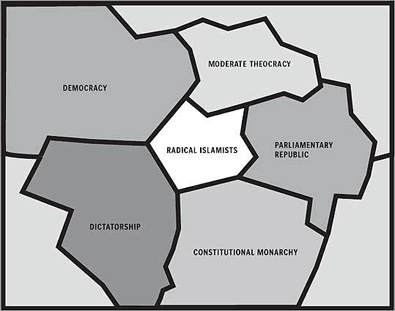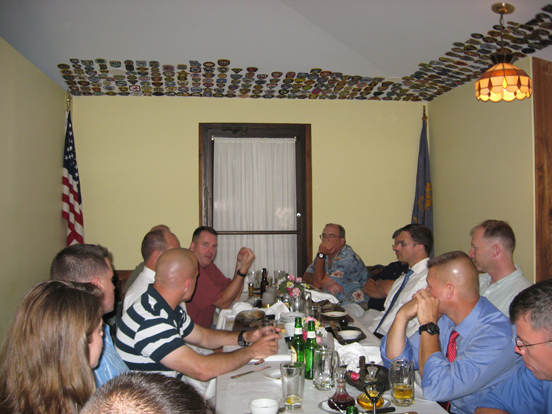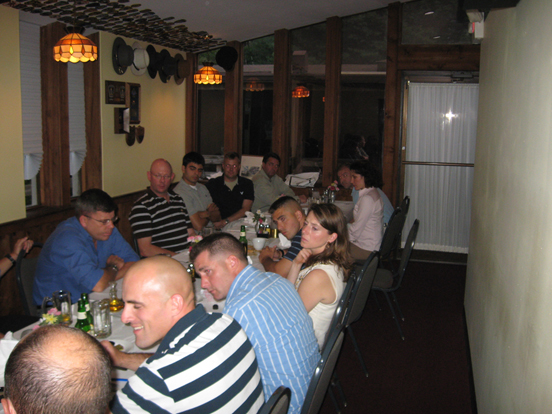How to Contain Radical Islam
The best global strategy for the US may be the one that won the Cold War.
By Commander Philip Kapusta and Captain Donovan Campbell

This article originally appeared in the 27 July edition of the Boston Globe and is posted here with permission of the authors and Globe.
The events of Sept. 11, 2001, brutally announced the presence of an enemy seemingly distinct from any our country had faced before. Unlike previous adversaries, such as Nazi Germany, Imperial Japan, or the Spanish monarchy, this new enemy was difficult to define, let alone understand. It was not motivated by causes that an avowedly secular government could easily comprehend, and it took an amorphous yet terrifying form with little historical precedent.
Our leaders responded to this new threat with dramatic changes. In the largest government reorganization of the past 50 years, the Department of Homeland Security lumbered into existence. A new director of national intelligence was named to oversee America's vast intelligence apparatus, and the defense of the homeland was made the military's top priority. Most dramatically, the United States announced - and then implemented - an aggressive new policy of preemptive war.
Yet, with the seventh anniversary of 9/11 approaching, it seems clear that policy makers have not responded particularly well. Islamic extremists are gaining strength, while America finds itself increasingly isolated in the world. The coalition of the willing, never overly robust, is now on life support. In the Middle East, the Islamist parties Hezbollah and Hamas have enough popular support to prosper in free and fair elections, and Al Qaeda is adding franchise chapters in North Africa, the Levant, the Arabian Peninsula, and elsewhere. Our most prominent post- 9/11 action remains the Iraq war, which has arguably failed to improve America's national security even as it has strengthened the position of our sworn enemies in the government of Iran.
Underlying these global setbacks is a core problem: The United States has yet to formulate a holistic strategy to guide the prosecution of our new war. We have not articulated a clear set of mutually reinforcing goals, and we have not undertaken a consistent set of actions designed to achieve our aims even as they demonstrate our national values. Indeed, we have not even managed to properly identify our enemies; despite the rhetoric of the past seven years, America is not at war with terror, because terror is not a foe but a tactic.
Blundering forward, we have squandered the swell of global good will after 9/11, punished our friends, and rewarded our enemies with shortsighted, even self-destructive, tactics.
Yet what we face today is not wholly novel: It is a war of ideas, mirroring the Cold War. Like the Communists, violent Islamic extremists are trying to spread a worldview that denigrates personal liberty and demands submission to a narrow ideology. And, as with the Cold War, it must be our goal to stop them. The United States should therefore adopt a new version of the policy that served us so well during that last long war: containment.
A policy of "neocontainment" would avoid self-defeating military confrontations in favor of an aggressive campaign to isolate our enemies. The modern equivalent of the Soviet Bloc, that geographic haven for a hostile ideology, is the arc of instability that extends from Central Asia west through Iran and the Arabian Peninsula and south across North Africa. We should build a virtual wall of stable, moderate nations on the periphery of that arc, literally containing the spread of the hostile belief system. More broadly, we must enter into - and prevail in - the war of ideas, winning the hearts and minds of both domestic and foreign audiences. We must pursue this goal not only in the mental arena - in what has been variously describe as political warfare, propaganda, or psychological operations - but also in the practical one, by consistently demonstrating our belief system in action. Our deeds are more important than anything we say, and in the aggressive prosecution of our war on terror, we have strayed from our core value of individual freedom.
Of course, neocontainment will have to address the important differences between the conflicts of today and yesterday. Today's threat emanates not from a hypergoverned nation-state but from a loosely networked group of radicals based primarily in undergoverned areas of the world - which makes carefully defining and targeting our true foes all the more important. Just as we strove to separate the Soviet elites from the people they repressively ruled, now we must separate the Islamic radicals from the vast majority of Muslims. We cannot, and should not, target an entire religion.
There is also a crucial difference in the danger's scale. For four decades, the USSR and its massive nuclear arsenal posed a clear existential threat to the United States. In contrast, today's extremists cannot eliminate our nation. We need to ratchet down the doomsday rhetoric and the military-driven response. Our primary ideological export should not be fear; it should be hope. We are at war with people and their belief systems, and ideas cannot be killed by bullets. They can only be killed by better ideas.
Without a coherent strategy, America's "war on terror" has been tragically inconsistent. We say that our mandate is to spread freedom and democracy, yet we try to do so at the point of a gun. We say that our battle must be fought by a coalition of like-minded allies, but we eschew diplomacy and browbeat our friends when they disagree with us. We say that we stand for the highest human ideals, but the world harbors deep suspicions of our indefinite detentions at Guantanamo.
Our contradictory words and actions have alienated virtually the entire Arab world. NATO remains fractured and largely ineffectual against the resurgent Taliban, and the Washington clock has run out on the Iraq war. We have elevated Al Qaeda's importance to nearly our own, and we are moving into a deadly no-man's-land where America is neither respected nor feared. It is almost inconceivable, and yet it has come to this: We are losing the global influence war to people who blow up women and children at kebab stands.
But if we can retool and take the long view, as the architects of Cold War containment did, we will watch Islamic extremism collapse under the weight of its own contradictions - witness the recent grass-roots uprising against Al Qaeda in Iraq. Like Marxism, militant Islam is long on promising the violent overthrow of the materialistic West and short on fashioning actual utopias.
The original doctrine of containment had its roots in a time of uncertainty much like our own. By the end of World War II, the United States was the dominant global power, and for a brief period there was hope that the world might fashion a lasting peace under the fledgling United Nations.
By 1949, however, it was clear that the world was bifurcating, and that this constituted a serious challenge to our security. The Soviet Union became the second nuclear-armed superpower, China fell to Communism, and the proliferation of ballistic missiles threatened the American homeland. Coming on the heels of the decisive triumph of the war, the new Communist threat generated the same feelings of vulnerability and confusion that the 9/11 attacks would foster decades later.
To respond to this changing world, senior national security officials writing for President Harry Truman articulated a new kind of policy. Drawing heavily from articles written by the American diplomat George Kennan, the landmark National Security Council Report 68 (NSC-68) outlined a strategy of containment that served as the core of American foreign policy for every president from Truman to Reagan.
Presciently, NSC-68 identified the essential clash between the United States and the Soviet Union as one between diametrically opposed ideologies. On the Soviet side was a dogmatic belief system that demanded absolute submission of individual freedom and sought to impose its authority over the rest of the world. On the American side was an ideology premised on the overriding value of freedom, a system founded upon the dignity and worth of the individual. This ideology relied upon its inherent appeal, and did not aim to bring other societies into conformity through force of arms.
The policy of containment represented a tectonic shift from the military-centric, unconditional-surrender mentality of World War II. War was now the option of last resort. Coercion through violence represented a contradiction for any free people, and, used improperly, it could undermine the global appeal of the American belief system. Thus, containment did not define success as the military defeat and unconditional surrender of the Soviet regime. It had more modest ambitions: geographic isolation of the communist belief system and slow change over time. By fighting a global struggle for influence, the thinking went, America could avoid a costly full-scale war against the Soviets.
Of course, force was employed on a number of occasions in proxy wars across the globe, such as Vietnam and Korea. They had serious costs, but compared with a potential all-out war against the USSR, these conflicts remained limited efforts to contain the geographic footprint of the Soviet ideology. And though the American defense budget increased over time, it never became the same drain on our economy that military spending was for the Soviets.
The path dictated by NSC-68 was not a straight line to the collapse of the USSR, but the strategy proved remarkably effective. Communism expanded outside of its containment zone in a few instances, but, for the most part, the United States and its allies successfully implemented the indirect approach recommended by NSC-68. When the once mighty Soviet empire imploded in 1991, it was almost precisely as NSC-68 had predicted.
Strikingly, if one replaces "communism" with "Islamic extremism" and "the Kremlin" with "Al-Qaeda," NSC-68 could have been written in 2002, not 1950. Like communism, Islamic extremism lusts for political power, in this case through the restoration of the caliphate and the imposition of Sharia law on all peoples. Indeed, language from NSC-68 rings eerily true today - it described the Soviets as "animated by a new fanatic faith, antithetical to our own." Al Qaeda and its ilk are the latest in a long line of narrow ideologies that claim to provide the only true answer to life's existential questions. And as with Soviet communism, the idea has a geographic nucleus.
Our task now is to envelop this nucleus with prosperous, stable countries whose inhabitants are free to choose their own beliefs. Working from the outside in, the United States must partner with nations on the periphery to help them build a stronger middle class, enhance their education systems, improve basic health, and lower government corruption. We must help elected and unelected governments to allow greater empowerment of their citizens, whether through a slow march toward representative government or expanded economic opportunity for all classes.
Lebanon in the Middle East and Pakistan in Central Asia are some of the best countries in which to begin and expand this work. In Lebanon's complex political landscape, Iran and Syria support the Islamist Hezbollah party-cum-militia, while the United States backs the secular Lebanese government. Another Islamist movement, Fatah al Islam, enjoys a nebulous connection to Al Qaeda. We should be using our country's massive financial resources to allow the Lebanese government to outspend its competitors by a factor of 10, showering much-needed aid on the Lebanese people, and thus de-legitimizing their opponents and debunking their ideology. Instead, the government cannot meet its basic responsibilities, and extremist movements are increasingly seen as the only institutions capable of bettering lives.
In Pakistan, the extremist cancer in the northwestern provinces continues to grow despite $5.5 billion in direct US military aid. Pakistan's dangerously unstable new civilian government lacks the capability and will to challenge Al Qaeda and the Taliban in the region. Instead of focusing exclusively on military operations along the Afghanistan/Pakistan border, America must broaden its scope to encompass other priorities: tension with India over Kashmir and education reform. Only after a comprehensive Indo/Pakistani border settlement will Pakistan shift its military energy from south to north. In the interim, it will placate us with occasional forays into the frontier provinces, but such adventures will never be decisive. We must also help Pakistan provide a counterweight to the hundreds of Wahabi madrassas spreading virulent extremism. As long as these fundamentalist institutions remain the only option for much of the country's poor, Islamic extremists in the tribal areas will enjoy a virtually inexhaustible manpower pool. In the long run, 5,000 secular teachers for Pakistan's middle schools will do more for America's national security than will 50,000 AK-47s for the country's army.
A clear new containment strategy will help us recognize the importance of engaging with such nations at pivotal points before they slide into repressive autocracy (Pakistan in 2001) or all-out chaos (Afghanistan in 1989).
It is popular to blame these failings on the attention and resource deficits created by the Iraq war. But they are just as much the result of the black-and-white mentality that governs our approach to foreign affairs - liberal democracy or nothing. In working with periphery states, we must be —to accept outcomes that are less than perfect. Indeed, we must be —to accept ruling regimes that may not like us at all. We are not trying to create mini-Americas scattered across the globe; we are looking to foster stable, free countries whose people will have little interest in the repressive ideology of our enemies.
On occasion, extremist governments hostile to the existence of the United States (Hamas in the Gaza Strip) will enjoy broad popular support, but preemptive wars must become a thing of the past. We cannot say that we value freedom and then seek political change through force when the choice of the people produces regimes not to our liking. However, the military can, and must, be used to target individuals bent on terror aimed at American interests. Furthermore, if a nation enables attacks on our homeland, as Afghanistan did under the Taliban, then we must use all necessary means to defend ourselves. On rare occasions, this will require full-out war and post-invasion reconstruction.
Retrospectively, the neocontainment framework would have supported operations in Afghanistan. It is a country near the edge of the arc, and its then-rulers harbored extremists who had demonstrated the motive and means to substantially damage our nation. Compared with our original plan, though, neocontainment would have stressed the importance of dominating the postcombat phase by committing all implements of national power to the years of sustained effort required to rebuild Afghanistan.
In contrast, neocontainment would have argued against the invasion of Iraq. Allocating the same amount of effort and resources to bolstering nations ringing the region would have produced far more beneficial results than invading a country at its heart. By doing so, our actions strengthened the extremist narrative that there is a Western crusade against Islam, and Iran's Shia theocracy has been the biggest beneficiary of the power vacuum left by Saddam's demise.
Going forward, adopting a strategy of neocontainment will entail checking Iran's expansion efforts through proxies rather than direct strikes against the country itself. Just as we limited Soviet expansion without using overt force against the Warsaw Pact, so too can we contain the Iranian regime without flying B-2s over Tehran.
Furthermore, we must institutionalize the lessons learned so painfully over seven years of war. The military must dramatically improve its nation-building doctrine, capacity, and will, acknowledging that postwar stability is much more important in the long run than is dominating the active combat phase. We remain unchallenged in our ability to win conventional military conflicts, but we must develop the language skills, cultural awareness, and civil-affairs specialists necessary to prevail in unconventional campaigns and in fighting's messy aftermath.
Our next president will inherit a nation weary of war, a world skeptical of American motives and actions, and undecided conflicts in Iraq and Afghanistan. However, the energy and excitement of a government transition offer both the outgoing and incoming administrations the opportunity to take bold steps.
On the battlefield, it is at least as important to articulate what you are for as it is to define what you are against. In a war of ideas, this is even more critical. To do this across the world, nation by nation, will take time, and that does not come naturally to our fast paced, results-oriented society. But we need to muster the requisite patience. Untold numbers of lives hinge on it.
Navy Commander Philip Kapusta is currently serving as chief of strategic plans at Special Operations Command Central, in Tampa. Marine Captain Donovan Campbell recently returned from his third combat deployment. His book, "Joker One," will be published by Random House in March. The views expressed in this article are those of the authors and do not reflect the official policy or position of the Department of Defense or the US government.



